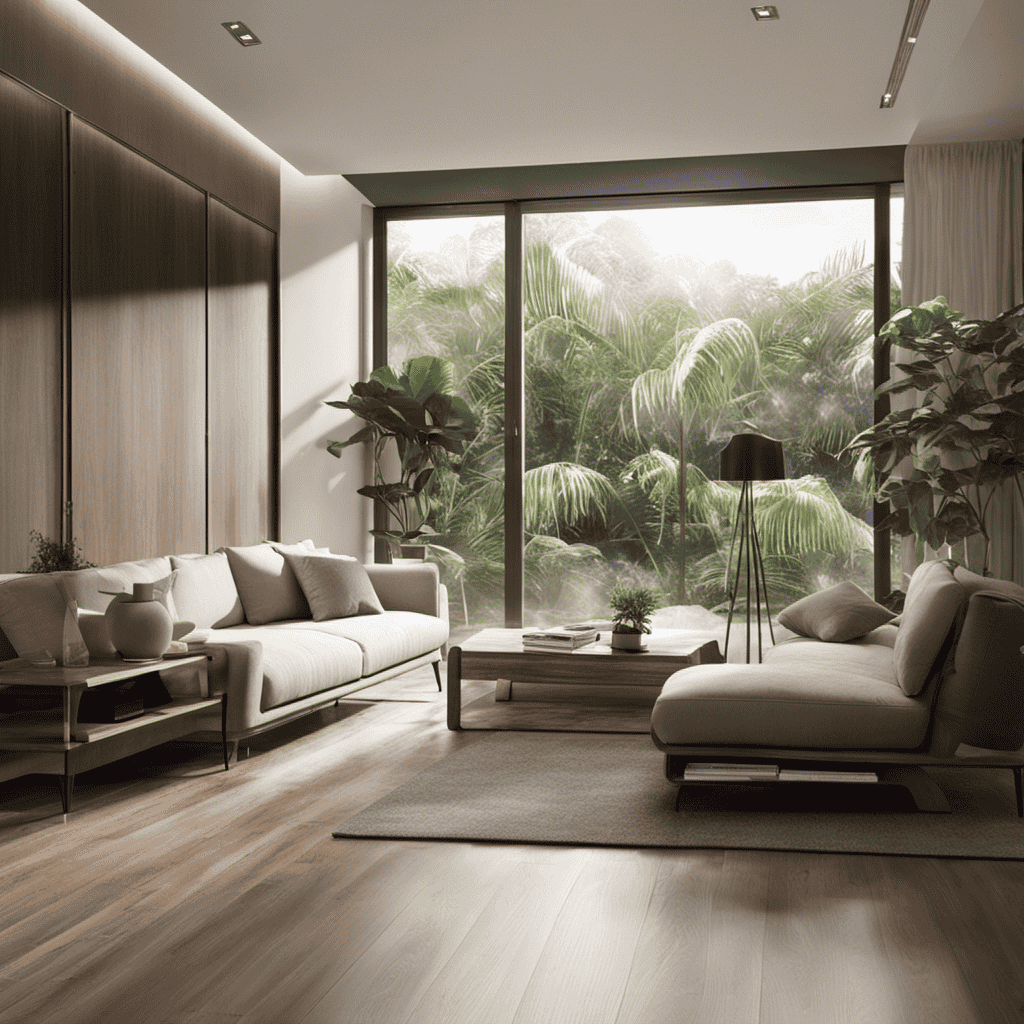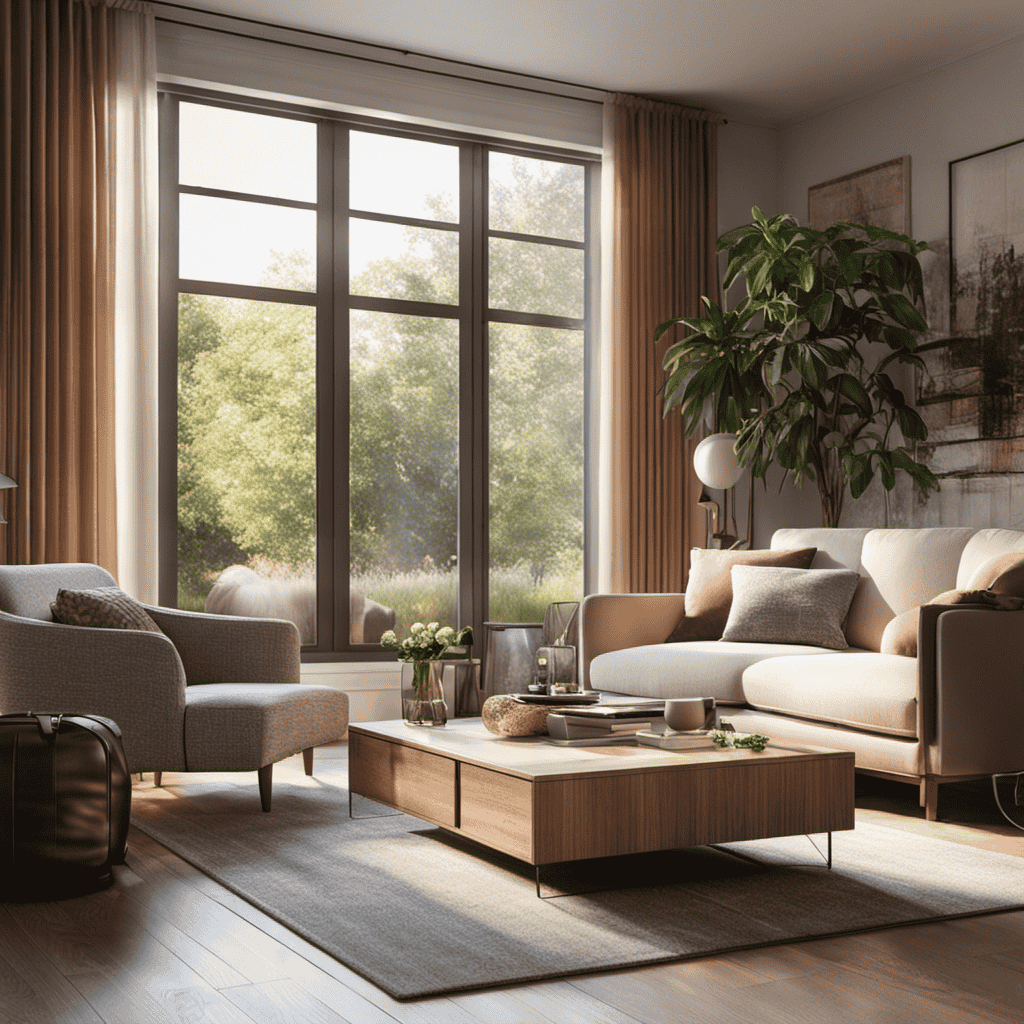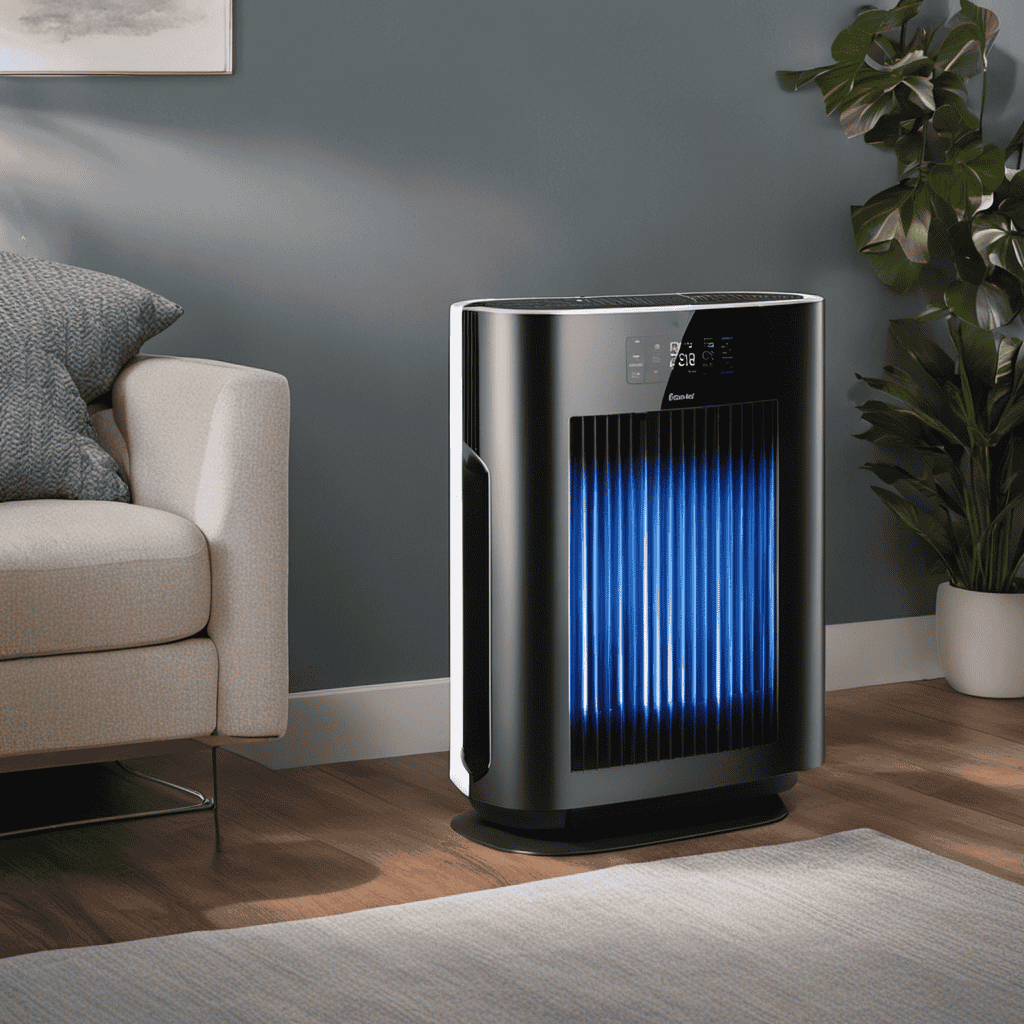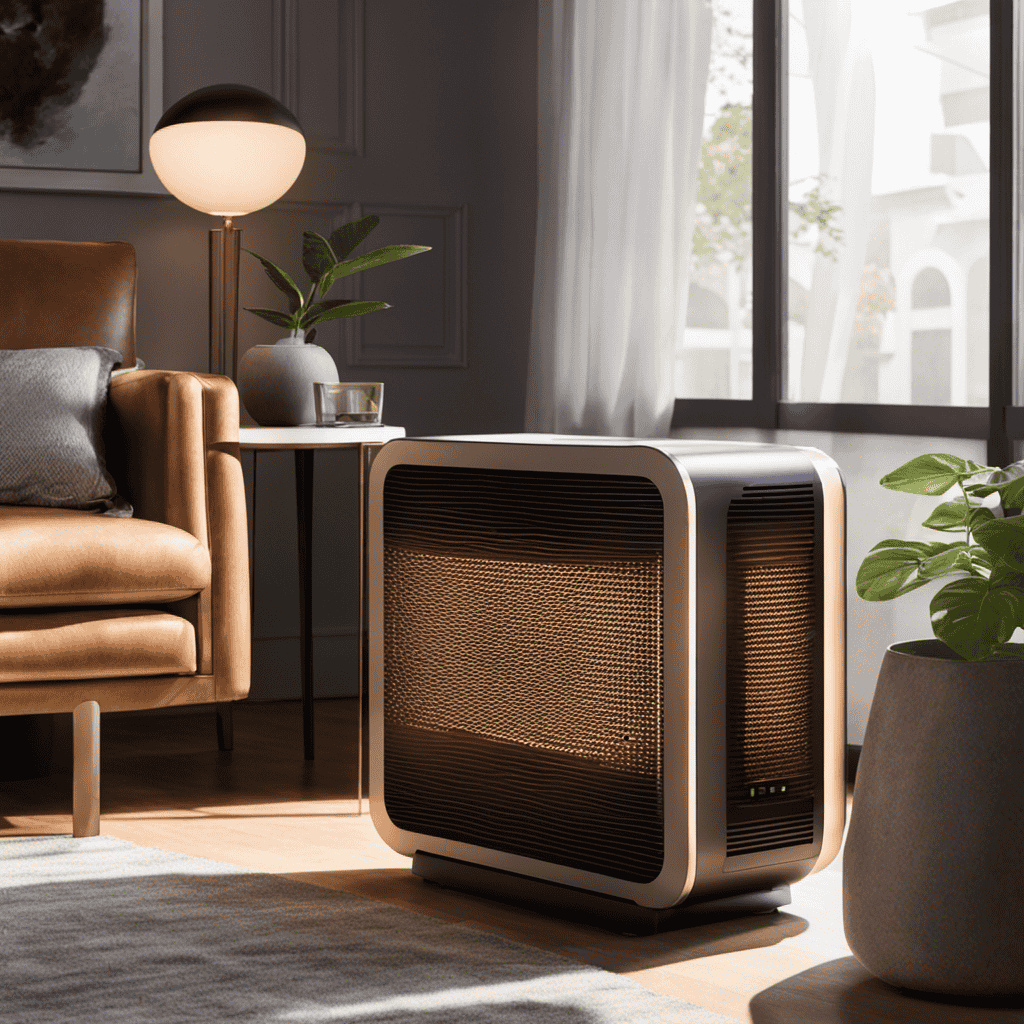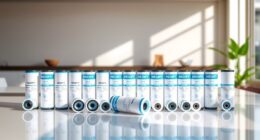I’ve always been curious about whether air purifiers are a good investment. Do they actually enhance indoor air quality? Are there any possible health hazards? And how do they stack up against natural ventilation?
In this article, we’ll dive deep into the pros and cons of air purifiers to help you make an informed decision. We’ll explore their effectiveness, benefits, and factors to consider when choosing one.
So, if you’re curious like me, keep reading to uncover the truth about air purifiers.
Key Takeaways
- Air purifiers improve indoor air quality by filtering out pollutants, allergens, and pathogens.
- They reduce the risk of respiratory illnesses and improve overall respiratory health.
- Air purifiers help remove specific pollutants like pet dander and cigarette smoke.
- Energy-efficient models can help lower monthly energy bills.
How Air Purifiers Improve Indoor Air Quality
You’ll be amazed at how air purifiers can drastically improve the quality of the air indoors. When it comes to respiratory health, air purifiers play a crucial role in removing harmful particles and allergens from the air we breathe. These devices are designed to capture and trap airborne particles such as dust, pollen, pet dander, mold spores, and even bacteria and viruses. By effectively removing these pollutants, air purifiers can help reduce the risk of allergies, asthma attacks, and other respiratory issues.
One of the main benefits of air purifiers is their ability to remove pet dander from the air. Many people love having pets at home, but pet dander can be a common allergen that triggers symptoms in individuals with allergies or asthma. Air purifiers with HEPA filters are particularly effective in capturing pet dander, as these filters can trap particles as small as 0.3 microns in size. This means that even the tiniest pet dander particles will be removed from the air, providing a cleaner and healthier environment for both humans and pets.
As we continue to explore the different types of air purifiers and their effectiveness, it is important to note that not all air purifiers are created equal.
Types of Air Purifiers and Their Effectiveness
When it comes to choosing an air purifier, understanding the different types of filters available is crucial. A comparison of filter types will help determine which one is most effective for removing specific pollutants from the air.
Additionally, considering the performance of air purifiers in small spaces is important, as some models might be more suitable for compact rooms or offices.
Lastly, energy consumption variations among different air purifiers should be taken into account to ensure that the chosen model is energy-efficient and cost-effective in the long run.
Filter Types Comparison
To compare filter types, you can examine the effectiveness and maintenance requirements of each option.
When it comes to HEPA vs. Carbon filters, there are some key differences to consider. HEPA filters are highly effective at removing airborne particles, such as dust, pollen, and pet dander. They can capture particles as small as 0.3 microns with an efficiency of 99.97%.
On the other hand, carbon filters excel at removing odors, gases, and chemicals from the air. They use activated carbon to trap these pollutants and can greatly improve indoor air quality.
When comparing Ionic vs. UV filters, it’s important to note that both technologies can be effective in killing bacteria and viruses. However, UV filters have an advantage as they can also neutralize mold spores and other allergens.
Overall, choosing the right filter type depends on your specific needs and concerns.
Performance in Small Spaces
In small spaces, HEPA filters are highly effective at capturing airborne particles, while carbon filters excel at removing odors and chemicals.
HEPA filters have several advantages in small spaces:
- High Efficiency: HEPA filters have a high efficiency rate of capturing particles as small as 0.3 microns, ensuring cleaner air in small rooms.
- Allergen Reduction: HEPA filters can effectively reduce allergens such as pollen, pet dander, and dust mites, making them ideal for people with allergies.
- Bacteria and Viruses: HEPA filters can also capture bacteria and viruses, improving the overall air quality.
However, there are limitations to consider:
- Limited Odor Removal: While HEPA filters can capture some odors, they are not specifically designed for odor removal.
- Chemicals: HEPA filters are not very effective at removing volatile organic compounds (VOCs) and other chemicals from the air.
- Maintenance: HEPA filters need to be regularly replaced to maintain their effectiveness.
Considering these advantages and limitations, it is important to weigh the specific needs of your small space before choosing the right air purifier. This leads us to the next section on energy consumption variations.
Energy Consumption Variations
You’ll want to consider the energy consumption variations when selecting the right air purifier for your small space. Energy efficient models can have a significant impact on your electricity bills, so it’s important to choose wisely.
According to a study conducted by Energy Star, air purifiers that are Energy Star certified use 40% less energy than standard models. This means that not only will you be improving the air quality in your home, but you’ll also be saving money in the long run.
When comparing different models, look for the Energy Star label and check the energy consumption ratings. Additionally, consider the size of your space and the recommended room size for the air purifier to ensure optimal energy efficiency.
Benefits of Using an Air Purifier in Your Home
When it comes to maintaining a healthy home environment, one of the key factors to consider is indoor air quality. Improved indoor air quality not only ensures a cleaner and fresher atmosphere but also has a significant impact on our overall health and well-being.
Air purifiers play a crucial role in achieving this by filtering out harmful pollutants and allergens, providing allergy relief and prevention.
Improved Indoor Air Quality
Using an air purifier can help improve your indoor air quality. Air purifiers are designed to filter out pollutants and contaminants from the air, resulting in cleaner and fresher air to breathe. Here are three ways an air purifier can benefit your indoor environment:
-
Reduction of pollutants: Air purifiers are effective in removing common indoor pollutants such as dust, pollen, pet dander, and mold spores. By removing these irritants from the air, an air purifier can help alleviate allergies and respiratory issues.
-
Improved sleep quality: Poor indoor air quality can disrupt sleep and lead to sleep-related problems. By purifying the air, an air purifier can create a more conducive sleep environment, allowing for better rest and improved overall sleep quality.
-
Odor elimination: Air purifiers equipped with activated carbon filters can effectively eliminate unpleasant odors caused by cooking, pets, or smoking. This can greatly improve the indoor air freshness and create a more pleasant living environment.
Investing in a high-quality air purifier can have a significant impact on your indoor air quality, leading to improved sleep quality and a reduction in pollutants that can negatively affect your health.
Allergy Relief and Prevention
Investing in an air purifier with a HEPA filter can greatly alleviate allergy symptoms and prevent allergens from circulating in your home. Air purifiers are especially effective in removing pet dander, which is a common trigger for allergies. Pet dander contains proteins that can cause allergic reactions in sensitive individuals, leading to symptoms such as sneezing, coughing, and itchy eyes. By capturing and trapping pet dander particles, air purifiers with HEPA filters can significantly reduce the presence of allergens in the air, providing relief to allergy sufferers.
Additionally, air purifiers can also help prevent respiratory illnesses by filtering out bacteria, viruses, and other airborne pathogens. The clean air provided by these devices can improve overall respiratory health and reduce the risk of getting sick.
Considering these benefits, it is important to carefully evaluate different factors when choosing an air purifier to ensure that you select the most suitable one for your specific needs.
Factors to Consider When Choosing an Air Purifier
To choose the right air purifier, you should consider factors like the size of the room and the specific pollutants you want to remove. There are various types of air purifiers available in the market, and understanding these factors will help you make an informed decision.
Here are three important factors to consider when choosing an air purifier:
-
Cost effectiveness: It’s important to consider the upfront cost of the air purifier as well as the long-term maintenance costs. Look for an air purifier that not only fits your budget but also provides good value for money in terms of its performance and durability.
-
Noise level: Some air purifiers can be quite noisy, which can be a nuisance, especially if you plan to use it in your bedroom or workspace. Look for models that have a quiet operation so that it doesn’t disrupt your sleep or concentration.
-
Air purifiers for specific needs: If you have specific concerns like pet dander or cigarette smoke, it’s important to choose an air purifier that is designed to effectively remove these pollutants. Look for models that have specialized filters or technologies that target these specific contaminants.
Considering these factors will help you narrow down your options and choose an air purifier that best suits your needs and preferences. Remember to also check customer reviews and ratings to get a better understanding of the performance and reliability of the air purifier you are considering.
Potential Health Risks Associated With Air Purifiers
If you’re concerned about potential health risks, it’s important to be aware of the possible side effects of using an air purifier. While air purifiers are generally considered safe and beneficial for improving indoor air quality, there are a few factors to consider regarding their long-term health effects.
One potential health risk associated with air purifiers is the production of ozone. Some types of air purifiers, such as those that use ionization or ozone generators, can release ozone as a byproduct. High levels of ozone can irritate the respiratory system, leading to coughing, chest pain, and shortness of breath. Prolonged exposure to ozone can also contribute to the development of respiratory conditions like asthma.
Another concern is the generation of ultrafine particles. Some air purifiers can produce these tiny particles, which can penetrate deep into the lungs and potentially cause inflammation and other respiratory problems. However, it’s important to note that the overall benefits of air purifiers in reducing larger particles, allergens, and pollutants outweigh the potential risks associated with ultrafine particles.
In conclusion, while air purifiers can provide significant benefits in improving indoor air quality, it’s crucial to consider the potential health risks associated with their use. By choosing air purifiers that do not produce ozone and minimizing exposure to ultrafine particles, you can mitigate these risks and ensure a safer environment for yourself and your family.
Now that we have discussed the potential health risks of air purifiers, let’s explore the cost and maintenance aspects of these devices.
Cost and Maintenance of Air Purifiers
When considering the cost and maintenance of air purifiers, there are several key points to keep in mind.
Firstly, the initial investment and cost of purchasing an air purifier can vary greatly depending on the brand, model, and features.
Secondly, filter replacement expenses should also be taken into account as filters need to be replaced periodically to maintain the effectiveness of the purifier.
Lastly, energy consumption and the resulting increase in energy bills are important factors to consider as some air purifiers can consume a significant amount of energy.
Initial Investment and Cost
You might be concerned about the initial investment and cost of an air purifier. While it’s true that purchasing an air purifier requires an initial investment, it’s important to consider its long-term cost effectiveness.
Here are three reasons why air purifiers are affordable in the long run:
-
Improved indoor air quality: Investing in an air purifier can greatly improve the quality of the air you breathe indoors. This can lead to better health and reduced medical expenses in the long term.
-
Energy-efficient models: Many air purifiers on the market today are designed to be energy-efficient, consuming minimal electricity while operating. This helps in reducing your monthly energy bills.
-
Durability and longevity: Air purifiers are built to last. With proper maintenance and regular filter replacements, a good quality air purifier can serve you for many years, making it a cost-effective investment.
Considering these factors, the initial investment in an air purifier is worth it for the long-term benefits it provides in terms of affordability and cost effectiveness.
Filter Replacement Expenses
Now that we have discussed the initial investment and cost of air purifiers, let’s move on to another important aspect: filter replacement expenses. When considering the cost effectiveness of owning an air purifier, it is crucial to factor in the lifespan of the filters and the frequency of replacement.
I have created a table below to illustrate the average lifespan and cost of replacement filters for some popular air purifier brands:
| Air Purifier Brand | Filter Lifespan (months) | Filter Replacement Cost |
|---|---|---|
| Brand A | 6 | $20 |
| Brand B | 12 | $30 |
| Brand C | 18 | $40 |
As you can see, the lifespan of filters varies among brands. While Brand A may require more frequent replacements, it has a lower replacement cost compared to Brand C. To determine the most cost-effective option, a lifespan analysis should be conducted, considering both the frequency of replacement and the cost of filters. By doing so, you can make an informed decision on which air purifier offers the best long-term value for your investment.
Energy Consumption and Bills
To minimize your energy consumption and bills, it is important to consider the efficiency of different air purifier models. Some models come with energy-saving features that can significantly reduce their impact on the environment. When choosing an air purifier, look for the following features:
-
Energy Star certification: This indicates that the air purifier meets strict energy efficiency guidelines set by the Environmental Protection Agency.
-
Adjustable fan speeds: Being able to adjust the fan speed allows you to control the amount of energy consumed based on your needs.
-
Timer function: This feature allows you to set specific operating times, ensuring that the air purifier is only on when necessary.
Considering these energy-saving features can help you reduce your energy consumption and lower your bills while still enjoying the benefits of clean air.
Now let’s explore some common misconceptions about air purifiers.
Common Misconceptions About Air Purifiers
One common misconception about air purifiers is that they eliminate all types of air pollution. While air purifiers are effective at removing some pollutants from the air, it is important to understand their limitations. Air purifiers work by filtering out particles and contaminants, such as dust, pet dander, and pollen. However, they are not capable of eliminating all types of air pollution, such as gases, chemicals, and odors. These misconceptions can lead to unrealistic expectations and disappointment for users.
Another misconception is that air purifiers alone can solve all allergy and asthma problems. While air purifiers can certainly help to reduce allergens in the air, they should be viewed as just one part of a comprehensive approach to managing allergies and asthma. It is important to also address other triggers, such as dust mites, mold, and pet dander, through regular cleaning and maintenance. Additionally, individuals with allergies and asthma should work with their healthcare providers to develop a personalized treatment plan that may include medications, lifestyle modifications, and other interventions.
How Air Purifiers Can Help With Allergies and Asthma
If you suffer from allergies or asthma, using an air purifier can provide relief by reducing the presence of allergens in your home. Indoor pollutants such as dust mites, pet dander, pollen, and mold spores can trigger allergic reactions and worsen asthma symptoms. An air purifier can help remove these particles from the air, improving respiratory health and overall well-being.
Here are three ways in which air purifiers can benefit those with allergies and asthma:
-
Filtering out allergens: Air purifiers are equipped with filters that can capture and trap microscopic allergens. HEPA filters, in particular, are highly effective at removing particles as small as 0.3 microns, including pollen and pet dander.
-
Reducing airborne mold spores: Mold spores are a common allergen that can cause respiratory issues. Air purifiers with UV-C light technology can help eliminate mold spores from the air, reducing the risk of allergic reactions.
-
Eliminating odors and chemical irritants: Some air purifiers are equipped with activated carbon filters that can absorb and neutralize odors and chemical irritants. This is particularly beneficial for individuals with sensitivities to strong odors or volatile organic compounds (VOCs).
The Impact of Air Purifiers on Energy Consumption
Using an air purifier can help you save on energy costs by reducing the need for excessive ventilation and air conditioning. Not only does it improve indoor air quality, but it also has energy-saving features that can make a significant impact on your environmental footprint.
One of the key energy-saving features of air purifiers is their ability to operate on low power settings. This means that they consume less energy compared to other appliances, resulting in reduced electricity usage and lower energy bills. Additionally, some air purifiers are designed with smart sensors that detect the air quality in a room and adjust their operation accordingly. This ensures that the purifier only runs when necessary, further conserving energy.
To better understand the environmental impact of using an air purifier, let’s take a look at the table below:
| Environmental Impact | Air Purifier |
|---|---|
| Energy Consumption | Low |
| Emissions | None |
| Waste Generation | Minimal |
| Resource Extraction | Minimal |
| Water Consumption | None |
As shown in the table, air purifiers have a low environmental impact. They consume minimal energy, produce no emissions, generate minimal waste, and require minimal resource extraction. Additionally, they do not require any water consumption, making them an eco-friendly option for improving indoor air quality.
Potential Noise and Odor Issues With Air Purifiers
To address potential noise and odor issues, you should consider researching air purifiers with noise reduction features and activated carbon filters. These features can help create a more peaceful and pleasant environment in your home or office.
Noise reduction technology ensures that the air purifier operates quietly, allowing you to work or sleep without any disturbances. Activated carbon filters are designed to effectively eliminate odors, trapping unpleasant smells and leaving the air fresh and clean.
When it comes to noise reduction, some top-rated air purifiers offer whisper-quiet operation, producing noise levels as low as 25 decibels. This is equivalent to the sound of a whisper or rustling leaves, ensuring that you won’t be bothered by any loud or disruptive noises.
Additionally, air purifiers with activated carbon filters are highly effective in removing odors caused by cooking, pets, smoke, and other sources. The activated carbon absorbs and neutralizes the odor molecules, leaving the air smelling clean and fresh.
Transitioning into the next section about ‘air purifiers vs. natural ventilation: which is better?’, it is important to consider both the noise reduction and odor elimination capabilities of air purifiers. While they can effectively address these issues, it is also worth exploring the benefits of natural ventilation in comparison.
Air Purifiers Vs. Natural Ventilation: Which Is Better?
When comparing air purifiers and natural ventilation, it’s important to consider their respective benefits and drawbacks.
Natural ventilation has several advantages. Firstly, it is a cost-effective option as it relies on opening windows or doors to allow fresh air to enter the space. This can help reduce energy consumption and lower electricity bills. Additionally, natural ventilation can provide a constant flow of fresh air, keeping the indoor environment well-ventilated and reducing the risk of indoor air pollution. It also allows for the removal of indoor pollutants, such as volatile organic compounds (VOCs) and allergens, by letting them escape through open windows.
On the other hand, air purifiers are specifically designed to remove contaminants from the air. They use filters and technologies like HEPA (high-efficiency particulate air) filters, activated carbon filters, and UV germicidal lamps to capture and eliminate pollutants. This makes air purifiers highly effective in improving indoor air quality, especially in spaces where natural ventilation is limited or not possible.
While natural ventilation is a more economical option, its effectiveness may vary depending on factors such as outdoor air quality and weather conditions. Air purifiers, on the other hand, provide a controlled and consistent purification process, ensuring that the air is free from pollutants regardless of external factors.
Are There Any New Advantages or Disadvantages of Air Purifiers That I Should Consider?
When researching the benefits of air purification, it’s important to consider the potential drawbacks as well. While air purifiers can remove harmful particles and allergens from the air, they may also produce ozone as a byproduct, which can be harmful in high concentrations. Additionally, some air purifiers can be expensive to maintain.
Frequently Asked Questions
Are Air Purifiers Effective in Removing Pet Dander and Pet Odors?
Yes, air purifiers can be effective in reducing pet dander and pet odors. They work by filtering out allergens and particles from the air, including pet dander and odors. This can greatly improve indoor air quality, making it easier for people with allergies or sensitivities to breathe.
However, the effectiveness of air purifiers can vary depending on the size and type of the purifier, as well as the specific needs and circumstances of the household.
Can Air Purifiers Help With Reducing the Spread of Airborne Viruses and Bacteria?
Air purifiers, oh how they promise to rid our homes of those pesky airborne viruses and bacteria! But do they really deliver on their lofty claims?
When it comes to reducing the spread of respiratory illnesses, the effectiveness of air purifiers is a topic of much debate. Some studies suggest that they can help to remove harmful particles from the air, while others argue that their impact is minimal.
Do Air Purifiers Eliminate All Types of Indoor Air Pollutants?
Air purifiers are effective in removing many types of indoor air pollutants. However, it’s important to note that they may not eliminate all types of pollutants.
While they can effectively remove smoke particles and other common pollutants like dust, pet dander, and pollen, they may not be as effective in removing certain gases, chemicals, and odors.
It’s crucial to choose an air purifier that is specifically designed to target the pollutants you are concerned about.
Are There Any Potential Side Effects or Health Risks Associated With Using an Air Purifier?
When it comes to air purifiers, it’s important to consider any potential risks or health effects.
While these devices are designed to improve indoor air quality, there are a few things to keep in mind.
Some people may experience irritation or allergic reactions to certain air purifier technologies.
Additionally, if not properly maintained, air purifiers can become breeding grounds for mold or bacteria.
It’s crucial to research and choose the right air purifier for your specific needs to minimize any potential side effects.
How Do Air Purifiers Compare to Other Methods of Improving Indoor Air Quality, Such as Ventilation or Using Indoor Plants?
When comparing air purifiers to other methods of improving indoor air quality, such as ventilation or using indoor plants, it’s important to consider their effectiveness.
While ventilation can help to circulate fresh air, it may not effectively remove pollutants or allergens.
Indoor plants can help to improve air quality, but they may not be as effective at removing specific contaminants.
Air purifiers, on the other hand, are designed to filter out pollutants and allergens, providing a more targeted solution for improving indoor air quality.
Conclusion
In conclusion, after thoroughly analyzing the pros and cons of air purifiers, it is evident that they offer numerous benefits in improving indoor air quality. They are effective in removing harmful pollutants and allergens, providing relief to those with allergies and asthma.
However, it is crucial to consider factors such as energy consumption, noise levels, and potential health risks associated with air purifiers. While they can be a valuable addition to your home, it is essential to weigh the advantages and disadvantages before making a decision.
As the saying goes, ‘knowledge is power,’ and being well-informed will help you make the best choice for your indoor environment.
